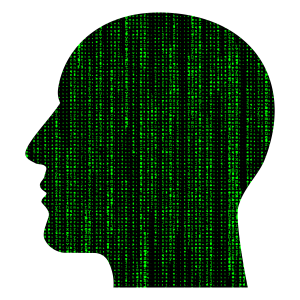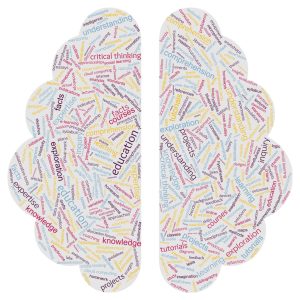Bloom’s and Generative AI
 AI is a growing part of our landscape, and some of the new tools are amazing. AI is helping to detect and diagnose disease earlier and more accurately. It’s central to the development of self-driving cars. And it’s helping to reduce the environmental impact of agriculture. Other uses are more mundane, like helping to plan meals or workouts.
AI is a growing part of our landscape, and some of the new tools are amazing. AI is helping to detect and diagnose disease earlier and more accurately. It’s central to the development of self-driving cars. And it’s helping to reduce the environmental impact of agriculture. Other uses are more mundane, like helping to plan meals or workouts.
At first, I heard from students and educators who thought that AI might take over writing for us. Now, while some folks might wish that were true, we’re finding that it’s really not. Writing is a skill that is intimately connected with thinking, and while AI can help, it can’t think for us.
So where can AI help with writing? This chapter uses Bloom’s Taxonomy to guide our understanding about which parts of writing tasks AI can help with and which are better left to us humans.
AI, GenAI, and LLMs
People are talking about “AI,” but that’s really a misnomer. AI, artificial intelligence, isn’t really intelligent. It doesn’t think, and it isn’t conscious or self-aware.
The type of “AI” that produces text is a subset of AI called generative AI (genAI), which simply means that the AI produces (generates) output in response to a prompt. GenAI technologies for writing, like ChatGPT, are really just supercharged autocompletion programs. They predict the next word in a sentence and the next, and then predict what the next sentence will be and the one after that. Those predictions are made by large language models (LLMs) which combine a vast quantity of written text with a numerical analysis of what typically follows a given word or phrase.
In this chapter, I’ll use “generative AI” or “genAI” rather than the more general and less accurate term, “AI.” If you’d like to understand the terminology better, I recommend look at a site like CNET’s “ChatGPT Glossary” (Khan).
Bloom’s and GenAI
GenAI can’t think for us, but it can assist with our intellectual work, as long as we understand the kinds of work it does well. Bloom’s Taxonomy can help us break this down.
The Cognitive Process Dimension and GenAI
This chart[1] identifies GenAI’s strengths and human strengths using the revised version of Bloom’s cognitive dimension:
| Traditional Description | What GenAI Does Well |
What Humans Do Well |
|
| CREATE | Put elements together to form a coherent or functional whole; reorganize elements into a new pattern or structure | Remix or merge based on pre-existing patterns; suggest a range of alternatives | Formulate original content, incorporating divergent thinking and human judgement; collaborate; integrate content from human emotions, experiences, and cultural contexts |
| EVALUATE | Make judgements based on criteria and standards | Make basic judgements when provided a set of criteria; describe pros and cons of various positions or courses of action that are part of its dataset | Critique options and make judgements that involve ethical, cultural, and emotional considerations, including appraising consequences; engage in metacognitive reflection; use instinct |
| ANALYZE | Break material into its constituent parts and determine how the parts relate to one another and to an overall structure or purpose | Break down content into component parts; compare and contrast data; detect trends and themes; predict patterns based on historical data | Think critically, use reason, and apply emotional intelligence to determine which analytic tools are most useful and which aspects of an analysis are meaningful; interpret results and relate those to authentic problems, decisions, and choices |
| APPLY | Carry out or use a procedure in a given situation | Suggest application of known patterns, processes, models, or methods to new situations | Apply creativity, imagination, and intuition to idea and solution development; carry out processes in the physical world |
| UNDERSTAND | Construct meaning from instructional messages, including oral, written, and graphic communication | Rephrase a concept in different words; match up a related example; translate | Construct meaning using thought processes such as inference, interpretation, and comparison; integrate new knowledge with existing knowledge; contextualize information within emotional, moral, or ethical considerations |
| REMEMBER | Retrieve relevant knowledge from long-term memory | Recall data and information; list possible answers; define a term; construct a basic chronology | Recognize relevant information; recall current events; recall information in situations where technology is not readily accessible |
The table gives you an overview. Let’s look a little deeper at each of the dimensions, working from the bottom up.
Remember: GenAI is useful for retrieving information, but you’ll need to verify the output.
GenAI excels at retrieving data and information. For example, if you need some basic background information on an author or an organization, genAI can collect that for you, though you will need to decide whether the information is relevant for your purposes. In addition, for information that isn’t common knowledge, you will want to check the sources that your LLM provides to be sure that those sources exist, say what the genAI claims, and are reliable. As long as you verify the information, genAI is useful for tasks that require you to retrieve information.
Understand: GenAI doesn’t understand, but it may help you understand.
GenAI doesn’t understand anything and cannot make meaning. Those are human skills. GenAI can help you understand ideas by providing explanations or examples, but only a human is going to know whether an explanation makes sense. Think, for example, about the infamous advice that Google’s AI gave for gluing cheese on pizza to make it stick. I don’t recommend relying on genAI as anything more than an assistant for tasks involving understanding.
Apply: GenAI can help, but you are better at innovating in new situations.
GenAI is good at identifying patterns in data (see Analyze), and it can suggest applications of those patterns. When there is no established procedure to apply, humans are better at applying concepts and theories, in part because choosing the best method or the process with the least negative consequences is a judgement call (see Evaluate).
Analyze: GenAI excels at identifying patterns; you are better at using the output.
GenAI is very good at sifting through data to detect patterns. When it comes to writing, LLMs like ChatGPT can help you identify useful criteria for an analysis and make suggestions about lines of analytic reasoning. Keep in mind that genAI cannot make meaning, so determining which analytic approach to use and which results are relevant are up to you.
Evaluate: You do this much better than genAI.
Making judgements is not a strength of genAI. While LLMs can provide pros and cons of various positions, for example, genAI has no ability to move beyond providing quantifiable metrics or restating what others have said. It cannot critically examine those pros and cons, nor can it consider emotions or cultures or contexts. Only humans can really determine whether something is positive or not.
Create: You do this much much better than genAI.
While genAI output may seem “new” to us, it only produces derivative work, remixing what already exists. It can suggest alternative approaches, but it has no emotional or cultural experiences to draw on that would allow it to truly “create.” Humans are much better at this one.
In short, if you are looking for information or trying to identify patterns or processing lots of data, AI can help. But even in the tasks that AI is good at, you’re better off treating it as an assistant; your intellectual work really needs your brainpower.
The Knowledge Dimension and GenAI
 The knowledge dimension is much more direct than the cognitive process dimension. In short, if the knowledge is established, genAI can help. If the work requires new knowledge or personal knowledge, genAI is not particularly useful.
The knowledge dimension is much more direct than the cognitive process dimension. In short, if the knowledge is established, genAI can help. If the work requires new knowledge or personal knowledge, genAI is not particularly useful.
Factual Knowledge. GenAI retrieves information very well, as long as you keep the cautions below in mind.
Conceptual Knowledge. GenAI can provide information about well-established theories and principles. It may be able to help structure ideas according to established lines of reasoning, but it doesn’t have the ability to come up with new theories or organizational structures. That’s a human skill.
Procedural Knowledge. Like conceptual knowledge, genAI can produce information on established procedures, but it doesn’t produce new methods. Again, that’s a human skill.
Metacognitive Knowledge. GenAI doesn’t help much here. Because genAI doesn’t think, it’s not going to be able to explain how you are thinking, though it may be able to give you some ideas about approaches to metacognition. Of all of kinds of knowledge in Bloom’s taxonomy, genAI is the least helpful here.
GenAI has another strength in this dimension, no matter the specific type of knowledge you are using: its ability to pull together information that you may not have thought of. The knowledge may not be “new,” but it may be new to you, which can give you ideas you haven’t previously thought of.
Cautions about Using AI
 I’ve briefly suggested some cautions about using genAI, but I want to say a little more here about some that are particularly relevant to writing.
I’ve briefly suggested some cautions about using genAI, but I want to say a little more here about some that are particularly relevant to writing.
Hallucinations
GenAI sometimes makes stuff up. For reasons I don’t understand, while summarizing Ross Gay’s “Some Thoughts on Mercy,” genAI turned the bees—a metaphor for a perceived threat—into rabbits, which are no threat at all except to my garden. It’s also been known to make up sources that don’t exist. Make sure you verify information produced by genAI.
Current Events
GenAI is trained on data “scraped” from the internet, but so far, it is not continuously updated. As of June 2024, ChatGPT-4, the current free version, has a cutoff date of January 2022. It knows nothing of the most recent war in Ukraine or the death of Queen Elizabeth II or the state of abortion laws in the United States after the Supreme Court overturned Roe v. Wade. If you are looking for current events, you won’t find it here.
Bias
Bias exists. A preference for one flavor (chocolate!) over another is a bias—an innocuous one, to be sure, but a bias nonetheless. We haven’t figured out how to completely eliminate bias, even when we want to, such as in medical studies or in our justice system.
GenAI has biases, too, most of them stemming from the data on which the LLM was trained. For example, LLMs that have been trained on historical data tend to favor stereotypical gender roles, make racist claims, and ignore cultural differences. Further, most LLMs are trained in English, so work in other languages is simply missing.
Unlike my preference for chocolate, these biases are not innocuous, and you need to watch for them.
Generic Results
GenAI produces polished writing: a focused thesis, developed paragraphs with topic sentences, no grammatical problems or spelling errors. It looks great—and the writing is completely bland. GenAI can help us strengthen our writing, but human thinking is what makes the written word interesting. You can let genAI help you strengthen your writing, but don’t ask it to write for you. It’s not very good at it.
GenAI’s Source Handling
As of this writing, ChatGPT-4, the latest free version, provides links to sources in its responses. For example, when I asked it about how much we spend on gardening in the United States each year, it gave me two informative sources (This Old House and Garden Pals). On the one hand, neither of these would qualify as acceptable sources for most college-level academic writing. On the other hand, the first of these included sources that would be credible. However, to know this, I needed to check out the sources themselves.
The sources chosen by genAI are not necessarily strong. Why cite This Old House instead of the National Gardening Association’s survey data and the U.S. Department of Agriculture’s economic projections, both cited in the This Old House piece? This goes back to the point about genAI and evaluation. Evaluation is not a genAI strength, but you can use your own judgement (and the skills you are gaining in your classes) to determine what is a useful source.
One more note on source handling: ChatGPT doesn’t always do a good job with citation formatting. I tested it on the citations for this chapter, and while it handled Sidney Dobrin’s book just fine, what it gave me back Vriti Saraf’s website was missing the author, and parts were just plain wrong.
AI as a Support in Your Writing Process
 So how can genAI help? We’ll talk more about your writing process in another section, but there are some concrete writing tasks where you can use genAI to help (assuming your professor approves). This part of the chapter provides a quick overview, but if you are looking for a more detailed guide, I recommend reading Sidney Dobrin’s AI and Writing.
So how can genAI help? We’ll talk more about your writing process in another section, but there are some concrete writing tasks where you can use genAI to help (assuming your professor approves). This part of the chapter provides a quick overview, but if you are looking for a more detailed guide, I recommend reading Sidney Dobrin’s AI and Writing.
Pre-Writing
GenAI is probably most helpful while you are producing ideas and gathering resources. A good chunk of the work in pre-writing involves Bloom’s remembering, something that genAI tends to do well. Here are some tasks that it’s good at:
- Generating ideas, focusing your topic, and coming up with different angles on your subject matter
- Locating sources, particularly if those sources are older and part of the data used in the LLM
- Collecting data and information on your topic, as long as you verify the results
In short, genAI can be helpful in getting you started, shaping your ideas, and getting you unstuck if you’re having trouble coming up with ideas.
Drafting
GenAI can help with strengthening a working thesis statement or suggesting organizational strategies based on a thesis or the assignment. Both of these tasks involve identify patterns (analysis), something that genAI does well.
Just be aware that genAI does not produce drafts. It produces final, polished prose that can be difficult to take apart. You are better off not using it to draft even parts of your paper unless your professor has told you to do this.
Revision
Revision relies on your judgement. However, because of its strengths in analysis, genAI can provide some useful feedback to help improve your draft work. You can—again, if your professor allows it—use AI to check everything from your reasoning to your style.
To get useful feedback, you will need to be specific in your prompts, and you may need to feed the genAI your assignment and any other instructions you have received. As with any request for feedback, the more specific your questions, the better.
Just keep in mind that you are the author, and just because genAI makes a suggestion doesn’t mean you have to follow it.
Editing and Proofreading
Because of its strengths in recalling information and analysis, GenAI can check grammar quite well. It can also do things like identify the verbs in your sentences and make suggestions for stronger ones, or help you reword a sentence that isn’t saying exactly what you want it to.
AI, Plagiarism, and Permission
 When ChatGPT first became widely available in November 2022, like any new technology, some people embraced it and some rejected it. In colleges and universities, professors worried most about plagiarism, about students copying writing from ChatGPT and turning it in as if it’s their own.
When ChatGPT first became widely available in November 2022, like any new technology, some people embraced it and some rejected it. In colleges and universities, professors worried most about plagiarism, about students copying writing from ChatGPT and turning it in as if it’s their own.
This concern has not gone away, and as a student writer, you will need to limit your genAI use to whatever your professor allows. If your professor says no AI, then don’t use it. If they say you can use it for idea generation, don’t start copying paragraphs. If you aren’t sure what’s acceptable, ask.
If your professor says that you can use it, check the professor’s requirements for documenting your use of genAI. Some of them may want you to include a statement explaining how you used it, and some may ask for citations. If you need to cite it, the major style guides all have instructions.
Media Attributions
“AI Matrix Head” by rawpixel is in the Public Domain, CC0
Caution, Photo by Goh Rhy Yan on Unsplash
Supported Tree, Photo by Neil Thomas on Unsplash
Raising Hands, Photo by Artem Maltsev on Unsplash
- The language in the “Traditional Description” column comes directly from Anderson and Krathwohl (67-68). Information and ideas that appear in the other columns derives from a combination of sources. I used two guides written for instructors: Oregon State University Ecampus’s “Bloom’s Taxonomy Revisited” and Fort Hays State University’s “AI Supported Learning Activities and Assignments.” I also used Vriti Saraf’s exploration of the intersection of Bloom and AI, and I returned directly to Anderson and Krathwohl, especially the material in Chapter 5, which explicates the revised cognitive process dimension in their model. ↵
Information that an educated reader would accept without having to look it up or that can be easily found in sources like dictionaries and encyclopedias.

